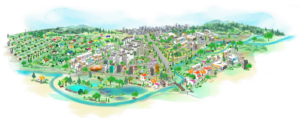Let’s green our cities! LIFE UrbanGreeningPlans leads the way
For two years, EUROPARC has been part of the LIFE UrbanGreeningPlans project that has tested innovative mechanisms and developed actions to plan, implement, strengthen, and manage green infrastructures in (peri-)urban areas. Now, the project has come to an end and a wealth of resources is available.
The LIFE UrbanGreeningPlans project has finalised after 2 years of intense work across 5 European cities and 2 NGOs. Through demonstrating and implementing innovative actions, sharing best practice case studies, and producing guidelines, the LIFE UrbanGreeningPlans project has paved the way for urban areas throughout Europe to include Green Infrastructure (GI), Nature-based Solutions (NbS) and the promotion of healthy ecosystems in their urban planning.
The different actions of the project build upon the wealth of experience from Europe’s Periuban Parks. The actions focussed around the central elements of Urban Greening Plans as indicated by the European Commission. These are:
![]()
Greening Plans Knowledge Hub
So, how to embark on the Urban Greening journey? To help cities start creating Urban Greening Plans, or take them to the next level, EUROPARC took on the task of creating a “Greening Plans Knowledge Hub” within the project. In this Knowledge Hub, you will find videos, podcasts, reports and much more to inspire you on how to enhance Biodiversity in your city or Periurban Park, and how to include Green Infrastructure (GI) and Nature-based Solutions (NbS) in urban plans.
Navigate the interactive map in search of resources by area type:
- Forests and semi-natural areas
- Agricultural areas
- Blue spaces
- Urban Green spaces
Or, use the topics indicated above to find the resources you are looking for!
This Knowledge Hub will be the long-lasting LIFE UrbanGreeningPlans project legacy.
It will be updated regularly. Are you working on this topic? Do you have anything to share? Please, fill in this form and we will upload your information in the hub.
Project recommendations
Furthermore, learnings from the project have resulted in the following set of recommendations for policymakers, planners, and managers to green our cities and set up Urban Greening Plans.
- URBAN GREENING PLANS NEED TO BECOME URGENT GREENING PLANS to adequately respond to Biodiversity loss and climate change.
- INCLUDE DIFFERENT SECTORS IN THE PLANNING PROCESS. Co-creating processes lead to better planned cities. By including different sectors and stakeholders in the planning process, more voices will be heard and acceptance will be higher.
- INCREASE GREEN SPACES through enlarging existing areas or purchasing new land to cool the city, increase biodiversity and give city dwellers more space for recreation.
- EXPAND THE WORKING AREA OF URBAN GARDENER BRIGADES to the outskirts of cities, also encompassing the periurban natural spaces.
- IMPROVE PRIVATE GARDENS IN CITIES; there is a huge potential to create more biodiverse private gardens through awareness-raising activities with citizens.
- INVOLVE CITIZENS IN MONITORING ACTIVITIES. It helps promote the importance of biodiversity and raises awareness of the public to biodiversity loss.
- RETHINK CURRENT INDICATORS TO IMPROVE BIODIVERSITY MONITORING. There is a need for a European index based on EU values regarding nature.
The EU Biodiversity Strategy 2030 calls upon cities with over 20.000 inhabitants to create Urban Greening Plans. These plans aim to bring nature back into cities to support biodiversity and mitigate climate change. This was the framework of the LIFE UrbanGreeningPlans project.

